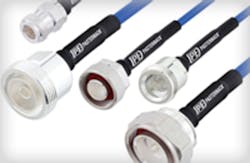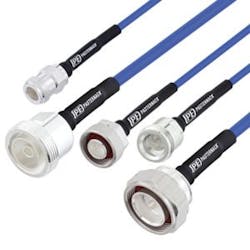Cables, connectors augment test applications
Interconnect technology has a key role to play in test-and-measurement applications, whether you need to make a few connections on a benchtop or many connections in an automated test system. Specifications you’ll need to keep in mind when choosing interconnect components might include electrical parameters like insertion loss, passive-intermodulation distortion, and phase and amplitude stability as well as the capability to accommodate high-speed digital signals compliant with standards such as USB 3.0, Serial ATA, HDMI, DVI and DVI-1, RJ45 Gigabit Ethernet, QSFP, Twinax, and Infiniband.
As for mechanical characteristics, you’ll need to consider factors like diameter, flexibility, connector type, and the number of connect/disconnect cycles that can occur without degrading performance.
Courtesy of Pasternack
RF/microwave connectors
Gore PHASEFLEX microwave test assemblies focus on applications up to 110 GHz requiring precise, repeatable measurements in a flexible cable. At 18 GHz and with the cable wrapped around a 75-mm-radius mandrel, typical phase stability ranges from ±3 degrees to ±8 degrees, depending on cable type, and typical amplitude stability is ±0.05 dB.
The cables can withstand continuous flexing, wide temperature ranges, and frequent connect/disconnect cycles to an instrument or device under test. They find use in benchtop testing, RF production test, and EMC test.
Mini-Circuits also offers flexible cables for RF/microwave applications. The company’s new CBL-NM-75+ series 75- precision test cables feature N-male to N-male connectors and rugged yet flexible cable construction for easy bending and connections in tight spaces. Like all of the company’s test cables, these new 75- models are performance-qualified to 20,000 flex cycles to withstand heavy use and frequent bending common in test environments. They come with a six-month product guarantee.
The cables provide 24-dB typical return loss and insertion loss as low as 0.27 dB, making them suitable for applications including production test stations, R&D labs, environmental and thermal test chambers, RF field testing, and cellular infrastructure site testing.
Times Microwave now offers a swept right angle for standard SilverLine bench-use test cables in unarmored configurations. These part numbers begin with SLU, SLULL, SLUSF, SLUTT, and SLU75. Swept right angles are a good alternative when customers require uncompromised RF performance, are working at frequencies above 18 GHz, and are using a less common interface series but must still have a 90-degree configuration. The new feature is a retrofit to existing hardware, allowing virtually every connector in the standard product line to become available in a right-angle configuration. A new revision of the standard SilverLine datasheet will be the first to indicate swept right angle availability. Prices will be slightly higher than straight connectors but less than cube right angles.
MegaPhase also offers test cables, including the BT Series for benchtop testing of CATV, video, IPTV, and broadcast products. A selection of 75- connectors complements the cables, which operate to a maximum frequency of 8 GHz, are designed to survive in rugged test environments, and provide stable performance under flexure, enabling repeatable measurements between calibrations. The cables are available in phase-matched sets and can be color-coded. Specs include a 66% nominal propagation velocity, 1.21-ns/ft time delay, and 15.8-pF/ft nominal capacitance. Shielding effectiveness is -110 dB minimum (cable only), and dielectric withstand voltage is 3 kV at 60 Hz. The company recently released an improved BT Series cable with an insertion loss of 0.316 dB/ft at 8 GHz, 18% lower than standard versions.
For applications sensitive to passive intermodulation distortion, Pasternack Enterprises recently introduced a series of low PIM cable jumpers with formable coax. These new assemblies are designed for low passive-intermodulation (PIM) applications including use in black boxes, test equipment racks and cabinets, distributed antenna systems, and lab testing.
Pasternack’s low PIM cables are made using a tin-filled braid that produces a hand-formable, solid outer conductor wall. The cables are available with two different coax diameters sizes including 0.163 inch and 0.276 inch. Connector options include 7/16 DIN, 4.1/9.5 mini-DIN, Type N, and SMA.
The connectors’ TriMetal plating, soldered connection point, and precise coaxial cable construction produce reliable low PIM performance for the life of the assembly. PIM performance is -160 dBc, and VSWR is 1.25:1. Between-series configurations can be ordered with SMA, type N, and 7/16 DIN connector combinations while in-series cables using 4.1/9.5 Mini DIN connectors also are available. The low PIM jumpers operate from DC up to 6 GHz. The assemblies are available for same-day shipment in 100-cm and 200-cm lengths; custom lengths are available with longer lead times. Each assembly is 100% RF and PIM tested prior to shipment.
HUBER+SUHNER makes cables and assemblies for communications, transportation, medical, and industrial applications, including analog and digital RF test. Examples of the company’s products include EACON assemblies, which are light, waterproof (IP68), and flexible cables that can be assembled in the field and serve industrial and defense applications to 18 GHz.
Mass interconnect
For making multiple contacts, VPC’s VTAC High Speed Data (HSD) connectors allow engineers in multiple industries to test devices that communicate at greater speeds and require higher data rates. The VTAC HSD insert features a data transfer rate of 12.5+ Gb/s per differential pair. Each VTAC HSD gold-plated, self-aligning contact has been tested and verified to 10,000 cycles without signal degradation. VTAC contacts work in both the iSeries and 90 Series connector families.
The connectors are scalable and can be customized to accommodate between eight and 272 individual contacts. They are reconfigurable, with VTAC inserts arranged in a desired location, and they can be rearranged to fit requirement needs. They are compatible with multiple HSD standards including USB 3.0, Serial ATA, HDMI, DVI and DVI-1, RJ45 Gigabit Ethernet, QSFP, Twinax, and Infiniband.
MAC Panel recently introduced the XBEAM performance optical connectors, which reliably join both single-mode and multimode optical fiber cables in the vendor’s SCOUT, TITAN, and Series 64 mass-interconnect systems. Since there is no physical fiber-to-fiber contact, there is no wear, cracking, or degrading of contact performance. The vendor’s expanded beam connection technology eliminates the need for cleaning. Typical insertion loss is 1.2-dB single-mode and 0.7-dB multimode. Typical power-handling capability is 500 mW.
Connector and cable tools
If you are assembling cables and connectors yourself, you’ll speed up the job and ensure proper performance of your assemblies with the appropriate tools. HUBER+SUHNER, for example, offers an assembly toolkit to easily connect the company’s BNC, N, QMA, and TNC connectors to its EACON cables.
And Times Microwave recently introduced its CCT-02 cable cutting tool, which replaces the older CCT-01 model. It is suitable for cutting any of the company’s LMR cables in preparation for connector termination. The CCT-02 tool provides a clean, sharp cut without leaving any metal or plastic residue across the face of the dielectric, and it allows the cable to retain its shape without distorting its geometry, thereby preventing any added return loss, which may be of particular concern at higher frequencies.
New features of the CCT-02 tool include a unique safety locking mechanism to keep the tool positively closed until needed or when stored in a pouch and a streamlined design that allows it to fit more easily into a Times or other type of tool pouch. The CCT-02 cable cutting tool has a list price of $48.00 each, the same as the tool it replaces.
For More Information

